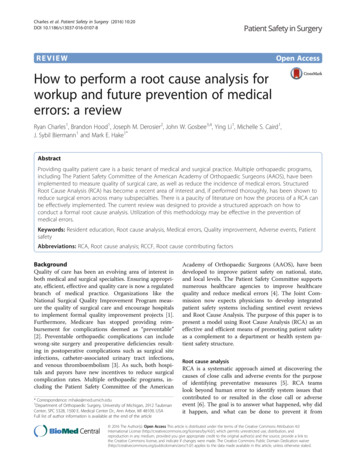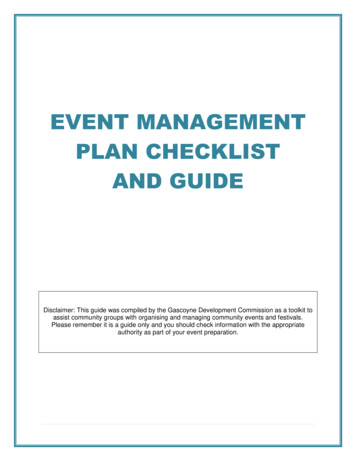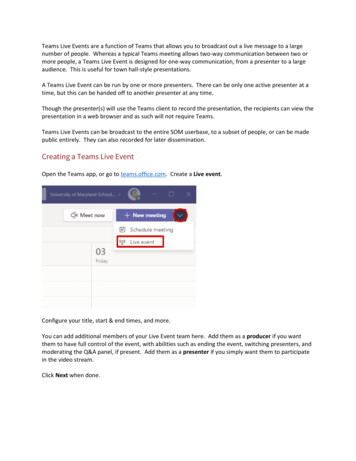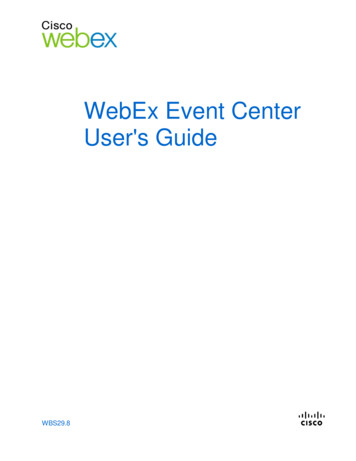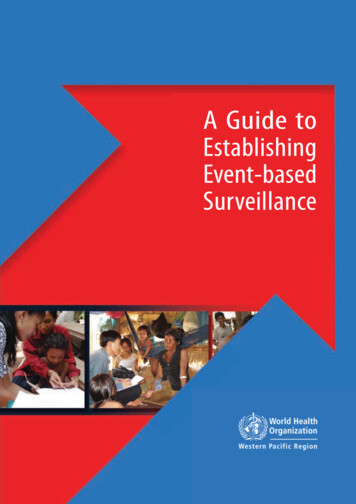
Transcription
A Guide toEstablishingEvent-basedSurveillance
A Guide to Establishing Event-Based Surveillance
A Guide toEstablishingEvent-basedSurveillance
WHO Library Cataloguing in Publication DataA guide to establishing event-based surveillance.1. Epidemiological factors. 2. Communicable diseases — epidemiology.ISBN 978 92 9061 321 3(NLM Classification: WA 110) World Health Organization 2008All rights reserved.The designations employed and the presentation of the material in this publication do not imply the expressionof any opinion whatsoever on the part of the World Health Organization concerning the legal status of anycountry, territory, city or area or of its authorities, or concerning the delimitation of its frontiers or boundaries.Dotted lines on maps represent approximate border lines for which there may not yet be full agreement.The mention of specific companies or of certain manufacturers’ products does not imply that they are endorsedor recommended by the World Health Organization in preference to others of a similar nature that are notmentioned. Errors and omissions excepted, the names of proprietary products are distinguished by initial capitalletters.The World Health Organization does not warrant that the information contained in this publication is completeand correct and shall not be liable for any damages incurred as a result of its use.Publications of the World Health Organization can be obtained from Marketing and Dissemination, World HealthOrganization, 20 Avenue Appia, 1211 Geneva 27, Switzerland (tel: 41 22 791 2476; fax: 41 22 791 4857;e-mail: bookorders@who.int). Requests for permission to reproduce WHO publications, in part or in whole,or to translate them – whether for sale or for noncommercial distribution – should be addressed to Publications,at the above address (fax: 41 22 791 4806; e-mail: permissions@who.int). For WHO Western Pacific RegionalPublications, request for permission to reproduce should be addressed to Publications Office, World HealthOrganization, Regional Office for the Western Pacific, P.O. Box 2932, 1000, Manila, Philippines, fax: 632 521 1036,e-mail: publications@wpro.who.int
Table of ContentsPurpose of the guide .3What is Event-based Surveillance .3Rationale for Event-based Surveillance .4Recommended Surveillance System Structure .6Reporting Structure .6Minimum Requirements .8Prioritizing Reporting Sources .8Stage 1: Using the Media .8Stage 2: Involving Health Care Workers .10Stage 3: Involving the Community .11Reporting Methods .12Minimum Requirements .12Hotlines .12HF/VHF Radio Communication .12Fax and E-mail .12Event Definitions .12Examples: Event Definitions .13Minimum Data Management Requirements .13Step One .13Step Two .14Step Three .15Step Four .15Surveillance Bulletin .15Confirmation and Assessment .15Example Event Confirmation Guidance .16Example Event Assessment Guidance .16Responding to an Event .18Routine Feedback .18External Links .18Monitoring and Evaluation .19Routine Monitoring .19Regular Evaluations .19Contributors .20A Guide to Establishing Event-Based Surveillance
AbbreviationsSARS Severe Acute Respiratory SyndromeAIAvian InfluenzaRR Rapid responseLFTS Long-Term Care facilitiesNGOs Non-Governmental OrganizationsSpecificitySensitivity A Guide to Establishing Event-Based Surveillance
Purpose of the guideIn line with the recommendations of the Asia Pacific Technical Advisory Group (TAG) on EmergingInfectious Diseases and in response to requests from Member States, the WHO Western Pacific RegionalOffice has developed the following guide for the design of event-based surveillance systems.What is Event-based Surveillance?Event-based surveillance is the organized and rapid capture of information about events that are apotential risk to public health. This information can be rumours and other ad-hoc reports transmittedthrough formal channels (i.e. established routine reporting systems) and informal channels (i.e. media,health workers and nongovernmental organizations reports), including: Events related to the occurrence of disease in humans, such as clustered cases of a diseaseor syndromes, unusual disease patterns or unexpected deaths as recognized by healthworkers and other key informants in the country; and Events related to potential exposure for humans, such as events related to diseasesand deaths in animals, contaminated food products or water, and environmental hazardsincluding chemical and radio-nuclear events.Information received through event-based surveillance should be rapidly assessed for the risk theevent poses to public health and responded to appropriately.Unlike classic surveillance, event-based surveillance is not based on the routine collection of dataand automated thresholds for action but rather on unstructured descriptions and reports. The definition of event-based surveillance has been adapted from the unpublished WHO EWARN guideline.A Guide to Establishing Event-Based Surveillance
Rationale for Event-basedSurveillanceEvent-based surveillance complements indicator-based surveillance. Both systems should be seen asessential components of a single national surveillance system (Fig. 1).Fig. 1. Surveillance and response systemEvent-based SurveillanceIndicator-based SurveillanceRapid detection, reporting, confirmation,assessment of public health events,includingRoutine reporting of cases of disease, including Notifiable disease surveillance systems Sentinel surveillance Laboratory based surveillance Clusters of disease Rumours of unexplained deathsCommonlyCommonly Health care facility based Weekly, monthly reporting Immediate reportingResponseLinked to surveillanceNational and subnational capacity to respond to alertsWhen it comes to the timely detection of outbreaks and important public health events, indicatorbased surveillance systems often fail. Furthermore, the systems are not suited to the detection of rarebut high-impact outbreaks (Severe Acute Respiratory Syndrome, Avian Influenza) or emerging andunknown diseases.Event-based surveillance systems rely on the immediate reporting of events (Table 1) and are designedto detect: Rare and new events that are not specifically included in indicator-based surveillance. Events that occur in populations which do not access health care through formal channels. A Guide to Establishing Event-Based Surveillance
Table 1. Comparison of key attributes and components of event-based and indicator-based efinitions can be used to help guide reporting.Definitions are broad, such as a cluster of deaths inthe same village during the same time period.Definitions are more sensitive than those used inindicator-based surveillance.Diseases and syndromes have a correspondingcase definition which may include one or all ofthe following: Clinical presentation Characteristics of people affected Laboratory criteriaDefintions are more specific than those used inevent-based surveillance.TimelinessAll events should be reported to the system immediately.Data are usually reported each week or month.Some diseases and syndromes may be immediatelynotifiable.Even where electronic reporting exists, a delayoften remains between case identification andwhen aggregated data are reported to the systemby a health facility.Where laboratory criteria are included in the casedefinition, a further delay in reporting may occur.Data/InformationThe data format is not pre-defined.Data are aggregated for each disease/syndrome.For each event as much information as possible iscollected and recorded.The data format is pre-defined and may include abreakdown by demographic and other variables(i.e. number of cases 0-4 and 5 years of age).Designated staff collecting the information attemptto obtain key pieces of information (i.e. time, place,person) to assist with event confirmation andassessment.ReportingstructureLoose structure.Clearly defined.Reports are unstructured and can enter the systemat any time.Reporting forms are used by reporting units topass information through the system often onpre-defined days of the week or month.Forms are used to capture the event information, butthe format is sufficiently flexible to collect qualitativeand quantitative data.A unit/team is designated to triage, confirm andassess each reported event and trigger a response,as appropriate.Zero reporting is often used.A unit/team is designated to analyse thesurveillance data at regular intervals.ReportingunitsOpen, sometimes undefined (i.e. the general public canreport directly to the system).Facility-based, closed.Trigger forinitial actionA report that is confirmed and assessed as a potentialrisk to public health.Pre-defined thresholds.AnalysisRapid risk assessment.Pre-defined intervals (weekly, monthly).ResponseImmediate.May be delayed as a result of the time takento collect and analyse data.The response to an event is built into the surveillancesystem.The response to an outbreak is built into thesurveillance system.A Guide to Establishing Event-Based Surveillance
Recommended Surveillance SystemStructureReporting StructureIdeally, an event-based surveillance system includes all potentially relevant reporting sources (Table 2).Table 2. Sources of Reports and Rumours for Event-based Surveillance SystemsMedical settingHealth carefacilitiesGeneral practitionersHeath clinicsHospitalsPathology servicesAllied health careprofessionals andorganizationsCommunity health workersMidwives/traditional birth attendantsTraditional healersLaboratoriesAmbulance servicesEnvironmental health officersHealth quarantine officersCommunity setting Community groupsDesignated community members:village leaders, village health volunteers, members of the publicCommunity servicesReligious c utilities (water and sanitation, environmental health)Nongovernmental organizationsGroup homes (elderly)Veterinary servicesMedia andpublished sourcesMedia (newspapers, radio, television)Academic pressInternetOtherMilitary organizationsEmbassiesUniversitiesA Guide to Establishing Event-Based Surveillance
In reality, resources are often limited and do not allow surveillance systems to incorporate all of thereporting sources listed above. Therefore reporting sources for event-based surveillance should beprioritized according to their: Sensitivity: Are they picking up all important events? Sustainability: How easily can they be maintained without undermining other public healthprograms?Fig. 2. Finding a balance between sensitivity and sustainabilitySensitivityNumber of confirmed publichealth events: Detected Assessed Responded toSustainabilityCosts Financial Human resources Impact on otherprogrammesMaintaining event reportingover timePrioritizing reporting sources should ensure a balance between the desired sensitivity of the system andthe resources available (Fig. 2). Therefore, each country is likely to identify a different set of reportingsources (Fig. 3).A Guide to Establishing Event-Based Surveillance
Fig. 3. Sensitivity of different reporting sources and level of resources required tomaintain the event-based surveillance system% Public health events detectedGeneral PublicCommunity OrganizationsCommunity Leaders/VolunteersHealth Care WorkersMediaEstablish rapid response capacity and event assessment teamResources availableMinimum RequirementsAn event assessment team/unit responsible for assessing each reported event and triggering animmediate response must exist BEFORE event-based surveillance is implemented. At a minimum, the team/unit should exist at the central level. Ideally, the central team should establish strong links with designated local staff who canassist with preliminary event confirmation and, where skills and resources exist, preliminaryevent assessment.Rapid response capacity must exist BEFORE event-based surveillance is implemented. National-level response with access to specialist skills (i.e. infection control, laboratory, riskcommunication). Local response with capacity to conduct a preliminary outbreak investigation.Prioritizing Reporting SourcesStage One: Using the MediaIn most developed and developing countries the media are the most important informal sourceof information on public health events. Therefore, all countries should include media sources inevent-based surveillance unless there are clear reasons for not doing so. A Guide to Establishing Event-Based Surveillance
Examples of media involvement in event-based surveillance1. Systematic searching of radio, print and electronic media for information about outbreaks. The event assessment team/unit should be responsible for carrying this out at thenational level. For large countries with active local press, consider having responsibleofficers at the subnational level. Responsible officers should screen the media on a daily basis taking full advantageof online media alert services (i.e. global news alert services, customised news alertsprovided by internet search engines). Where practical and where adequate funds are available, consider the use of electronicmedia survey systems. These are commercially available services that are marketed bymedia and communications companies.2. Ensuring that calls to health officials from the media about public health events arecaptured by the event-based surveillance system. Consider: Providing one hotline number so that all calls from the media can be screened andtriaged appropriately. Ensuring that all incoming calls are logged and basic information is collected (seepage 15; minimum data management requirements).3. Working with the media as partners, encourage the media to undertake active surveillanceof health events through their networks of reporters and journalists. Consider providing : Training on event-based surveillance to the media, highlighting their role in reportingrumours/events. Regular and timely updates on the assessment of the events that are reported throughthe media. Positive feedback about media involvement and appreciation to those actively involvedin the system.Advantages Credible media usually provide accurate reports of public health events. Easily accessible as the alerts are often available in electronic form. Few resources required for screening the media.Disadvantages Media reporting criteria is based on newsworthiness of the event and notnecessarily on the public health importance. In countries with heavily restricted or controlled media, public health eventsmay not be detected and picked up as frequently.A Guide to Establishing Event-Based Surveillance
Stage Two: Involving Health Care WorkersHealth care workers (HCW) can be involved in event-based surveillance as primary reporting sources,such as during patient consultations, or as secondary sources passing on rumours picked up throughpatient consultations.Examples of HCW involvement in event-based surveillance1. Enrol all HCW or designated institutional champions in event-based surveillance andprovide the appropriate training on how and when to report events.2. Include private sector and allied health professionals (i.e. staff at border crossings, ports,airports) where possible. It may be easier to engage the private health care sector in eventbased surveillance by: Highlighting that there is no routine reporting requirement. Tapping into clinicians’ social responsibility by focusing on the link between reportingand response. Attempting to minimize concerns about negative consequences of reporting unusualevents. Arranging for the event assessment team to provide technical support for patientdiagnosis or treatment when an event is reported.Advantages HCW are already involved in national surveillance and public healthprogrammes. Identifying institutional champions for event-based surveillance will help tomaintain interest and involvement in the system. HCW can take advantage of existing systems (i.e. using existingcommunication methods for immediate reporting of notifiable diseases toalso report events) and training programmes (i.e. including training onevent-based surveillance while carrying out other surveillance and responsetraining).Disadvantages HCW reporting is biased towards the detection of outbreaks/events amongpeople seeking care in the formal clinical and public health care sectors.10A Guide to Establishing Event-Based Surveillance
Stage Three: Involving the CommunityThe effective involvement of the community and general public in event-based surveillance relies onstriking a balance between their involvement in direct reporting and the resources available to assess,confirm and respond to the potentially large number of reported events.Examples of community involvement in event-based surveillance1. Direct community reporting: the general public report directly to national hotlines, websites,or health care facilities.a. Direct reporting must be accompanied by community awareness campaigns to ensurethat the general public know what to report and where to report.b.Where community members report events to health care facilities, arrangements needto be made for reporting outside clinic hours. Not all community members who arereporting an event will also seek medical care. It is important that reporting of eventsdoes not interfere with the provision of medical services and community membersshould be able to report events without the need for a clinical appoinment.2. Indirect reporting through community organizations (i.e. religious organizations, schools,long-term care facilities, public utilities and NGOs) and designated community members(i.e. community leaders and community health volunteers).Direct community accessAdvantages High sensitivity.Disadvantages Low specificity as there are likely to be many reports about events of no riskto public health. A large number of resources required to assess reports and respond to events.Indirect community accessAdvantages Higher specificity as targeted training for designated community membersor groups will help to reduce the number of reported events that can’t beconfirmed or are not potential risks to public health.Disadvantages Using designated members of community groups (community champions)to report may not be sustainable if: The response results in negative economic consequences for thecommunity. Reporting events is perceived as too much extra work.A Guide to Establishing Event-Based Surveillance11
Reporting MethodsMinimum Requirements1. All methods of immediate communication should be made available to those expected toparticipate in event-based surveillance – hotline (voice, SMS), e-mail, fax.2. Reporting should be possible 24 hours a day, 7 days a week.HotlinesWhere hotlines are used they will either be open to the general public or for restricted use (i.e. healthcare facilities, media or designated members of the community/community groups). The type ofhotline will be dependent on the reporting structure and the cultural context. If a decision is takento establish a hotline:1. Use only one toll-free telephone number. Where SMS and verbal reports are accepted tryto ensure that the telephone number is the same for both methods of communication.2. Rationalize and harmonize the number of hotlines to avoid confusion.HF/VHF Radio CommunicationIn countries where communication infrastructures are limited, radios can be used to report events.Where radio communication is the only reliable option, base station staff and radio operators wouldneed to be trained to triage event information to the event assessment team. Ideally, the event assessmentteam would be co-located with the base station to ensure that time delays are minimized.Fax and E-mailFax and e-mail can be used as a complementary communication method to a telephone hotlinebut rarely as primary means of communication. In many countries, hardware malfunctions andintermittent Internet access would further limit immediate reporting.Event DefinitionsAs indicator-based surveillance already uses case definitions for immediately notifiable diseases andclusters of disease/death, these definitions can also be used in event-based surveillance: As examples of events that should be reported. As events that are reported to the event surveillance system for confirmation, assessmentand, if appropriate, response.12A Guide to Establishing Event-Based Surveillance
Where communities, community organizations, and private/allied health care sectors are engaged inthe surveillance system, case definitions are not required and open reporting of unusual/unexpectedevents should be encouraged.Examples: Event DefinitionsThe following event definitions are examples of those used in countries with existing event-basedsurveillance systems.Symptom-based definitions for diseases in humansClusters of deaths in a health care facility, village, community, construction site, mine, school orother institution over a period of two weeks.Cluster of disease of unknown etiology: three cases or more of a disease of unknown etiology ina health care facility, village, community, construction site, mine, school or other institution over aperiod of two weeks.Any unusual event in the community which may affect human healthAny public health event that raises concern, fear and alarm in the community.An event which may have a known, suspected or possible impact on human health.Minimum Data Management RequirementsSystematic, structured data collection is a critical component of any surveillance system, including eventbased surveillance. For event-based surveillance, data collection has to be rapid and capture enoughinformation to allow for an initial assessment of the event. Information on each event reported shouldbe captured in a database where the outcomes, assessment and subsequent responses are logged.Step OneWhenever an event is reported, the person responsible for handling the initial contact should collect basicinformation about the event (Fig. 4) using a reporting form that includes: Unique identifier Geographical area (i.e. district) name Date of reporting and contact details of reporter Date and time when event occurred Description of event Actions taken to date, if anyA Guide to Establishing Event-Based Surveillance13
Fig. 4. An example of an event reporting formHealth Event ReportPlease send this to your Local Health Office or to your Regional Epidemiologyand Surveillance Unit (RESU)1Date(Today’s date)2What do you want to report? Whathappened?3When did this happen?(Month, day, year)4Where did this happen?(Municipality or City, Province, Region)5How many have been affected?6Has anyone died? How many?7Other information you have.8What is your name and contact number?Step TwoDuring event confirmation and assessment: Further information may be obtained by contacting other sources, i.e. hospitals, laboratories,schools. A decision will then need to be taken about further investigation and what actions shouldbe taken.Capture of additional information and decisions in the database simplifies information sharing andallows for automated reports to be generated and sent to different levels of the health system involved inresponse activities.14A Guide to Establishing Event-Based Surveillance
Fig. 5. An example of data recorded during event confirmation and assessment123456789101112131415Report Date and Time (When was the health event reported?)Confirmation Date (When was the health event confirmed?)Health Event (What happened?)Location (Municipality/City, Province, Region)Start Date (Date of onset of first case)Number of Cases (How many were affected? Attack Rates?)Description of Cases (Who were affected? When? Where?)Number of Deaths (Of the cases, how many died?)Description of Deaths (Who? When? Where? Why?)Actions Taken (Who? What? When?)Status of Health Event (Ongoing or controlled?)Who has been informed? (Local health departments, etc.)Source of information (Name, office number, mobile number)Is assistance needed? (If yes, please specify)Remarks (Other important information)Step ThreeDuring a response to an event, details of all decisions, requests for additional support, actions andimplementation of control measures should be collected and archived as a reference for future outbreaks/event investigations.Step FourAs with all successful surveillance systems, feedback to stakeholders should be routinely provided on anyreported event.Surveillance BulletinThe following aggregated data could be routinely reported in regular surveillance bulletins traditionallyused for feedback by indicator-based surveillance systems to stakeholders and decision-makers. Number of events reported Number of events assessed Number of events confirmed Number of events not confirmed (i.e. false rumours) Source of reporting (i.e. health care facility, community leader).When responses to events are undertaken, brief descriptions can be included in the surveillance bulletinto highlight the link between reporting and response.Feedback should be given to all reporting sources, people and organizations involved in event response.A Guide to Establishing Event-Based Surveillance15
Confirmation and AssessmentThe extent to which event confirmation and assessment can occur at the subnational level will dependon available resources.Where resources are limited, events should be reported directly to the event assessment team at thecentral level for confirmation and assessment within 24 hours of the initial event report. The speedwith which confirmation and assessment can be undertaken will depend on the links the central teamhas with local public health staff. Under the supervision of the central team, the involvement of localpublic health staff in event confirmation, and where possible preliminary assessment, will make thesystem more responsive. Report confirmation is the process by which a report from the community, media or healthcare worker can be substantiated, i.e. event is considered to be a REAL event. A real orconfirmed report does not mean, however, that the event is a potential risk to publichealth. Event assessment is the process by which the available information about a real event isanalyzed and a judgement is made as to whether it is a poses a risk to public health.Criteria can be used to direct staff that are involved i
6 A GuidE to EStAbliShinG EvEnt-bASEd SurvEillAncE Reporting Structure ideally, an event-based surveillance system includes all potentially relevant reporting sources (table ). table 2. Sources of Reports and Rumours for Event-based Surveillance Systems MEdICAL SEttINg Health care facilities General practitioners heath clinics hospitals .
